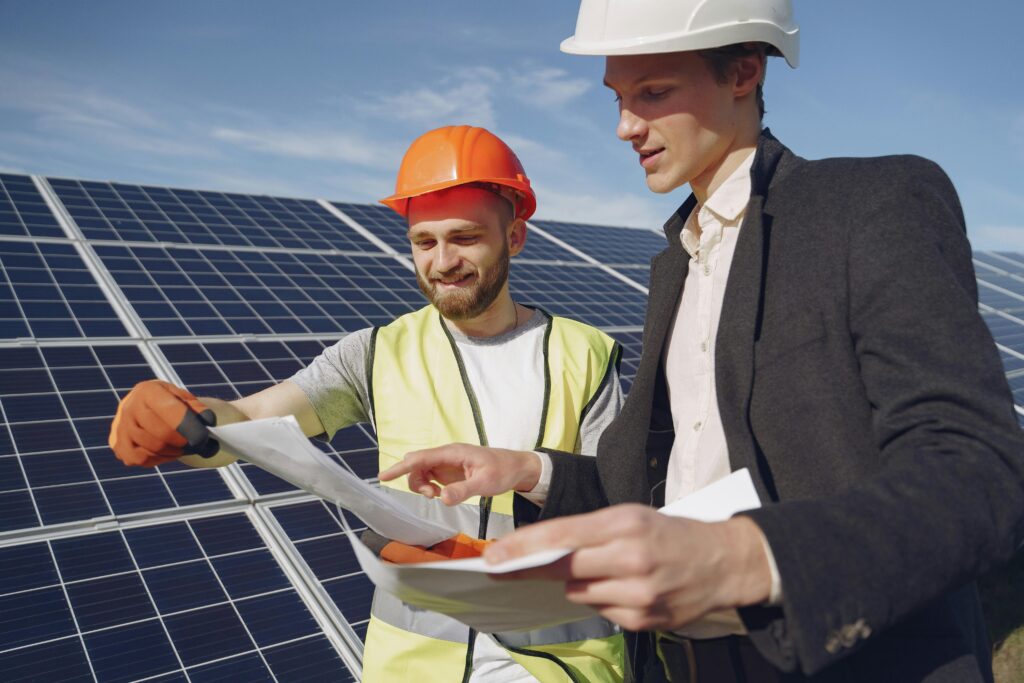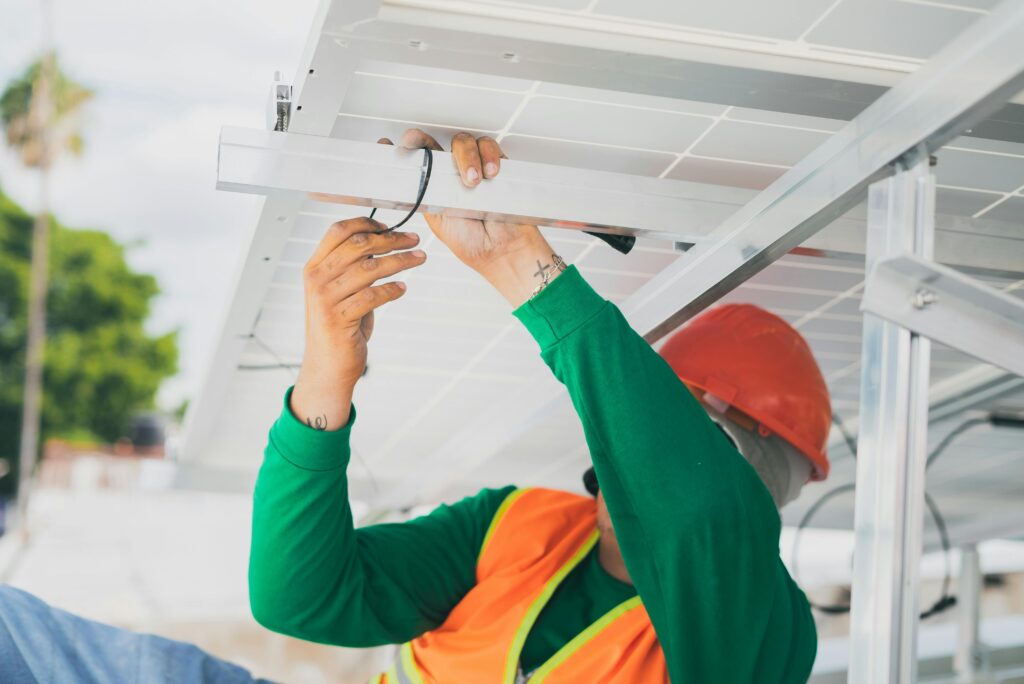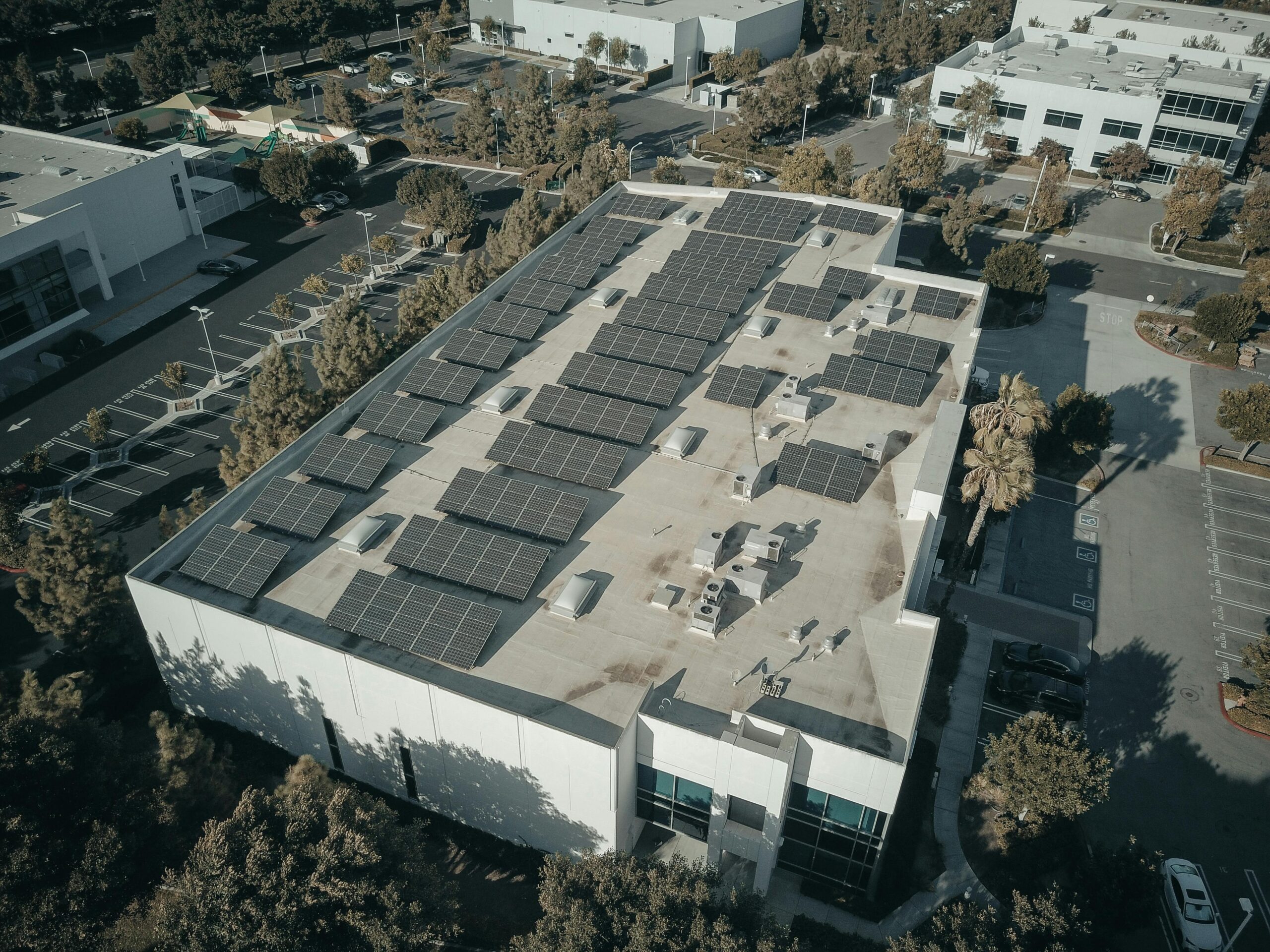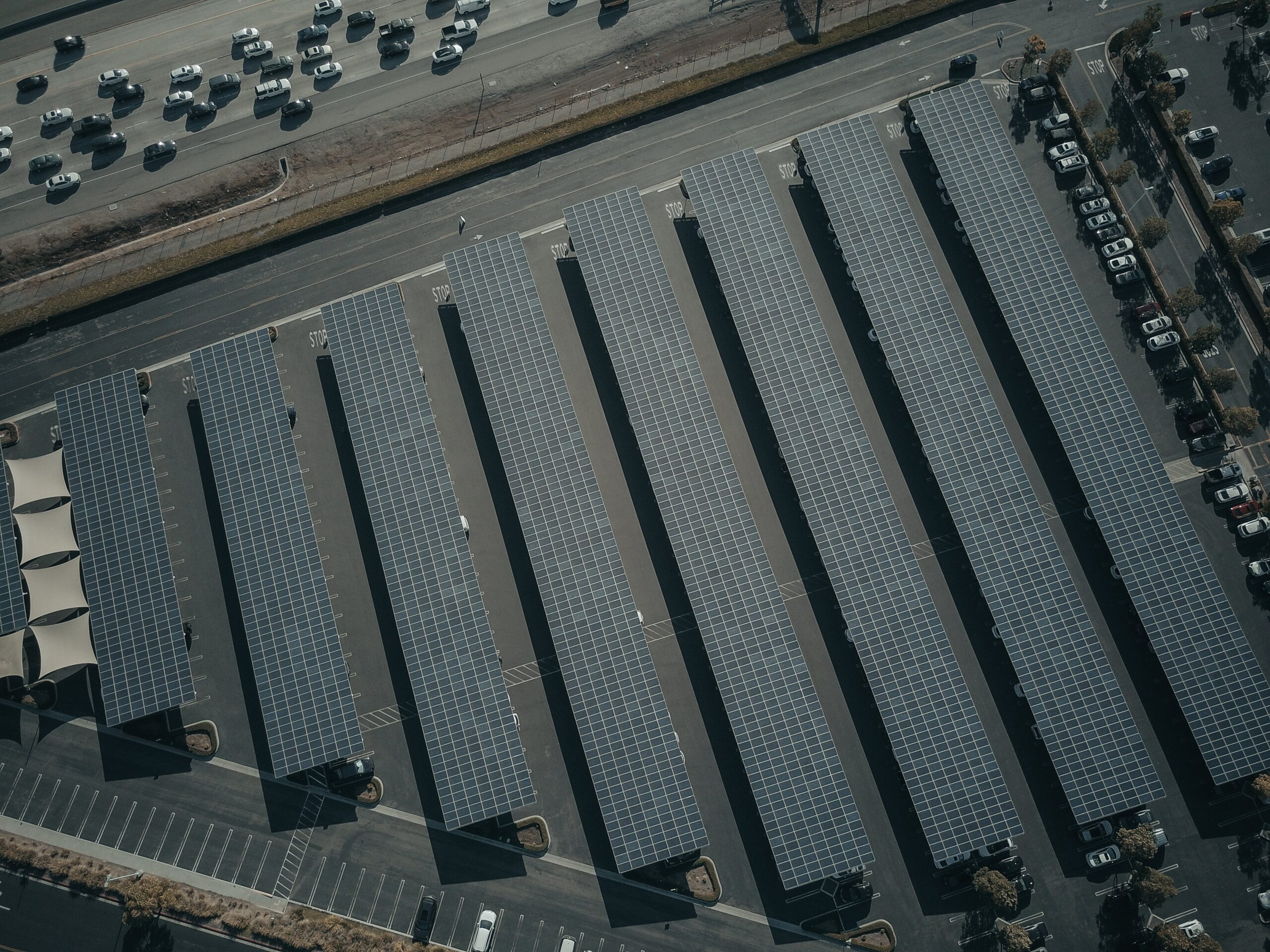Roof Space Limitations: Solutions for Small or Complex Roofs
Thinking about commercial solar installations but worried your roof might not have enough space? Don’t worry—you’re not alone! Many businesses face the challenge of limited or awkwardly shaped roof areas, but the good news is that solar technology has come a long way. Today, there are plenty of creative and efficient solutions to make solar work, even on small or complex roofs. Let’s explore some smart options to help you make the most of every inch of available space.
High-Efficiency Panels: Maximizing Power in a Small Footprint
When space is tight, it’s all about making every panel count. High-efficiency solar panels are designed to capture more sunlight per square foot than standard panels, making them perfect for commercial solar installations on small roofs. These panels use advanced materials and technology to generate as much energy as possible from each ray of sunlight. While they may cost a bit more upfront, their enhanced power output can make a huge difference, especially when you have limited room to work with.
Think of high-efficiency panels as the all-stars of the solar world, working harder to generate more power in less space. By choosing these panels, you can increase your energy output without needing additional roof space. It’s a win-win solution that lets you maximize your investment, even if your roof is small or uniquely shaped.
Creative Panel Layouts: Making the Most of an Odd-Shaped Roof
Not all roofs are simple, flat surfaces—many commercial roofs have unique designs, angles, or obstructions like HVAC units and vents. But that doesn’t mean solar power is off the table! With a little creative planning, your solar provider can design a custom panel layout to fit your roof’s unique shape. Using advanced design software, they can map out the best spots to place panels, ensuring optimal sun exposure while working around any obstacles.
This approach is especially useful for commercial solar installations where the roof space is limited or broken up into smaller sections. Solar engineers can arrange the panels in a way that maximizes energy production, even with space constraints. By tailoring the layout to your specific roof, you can still capture a significant amount of solar power without needing a large, open roof area.
Vertical or Wall-Mounted Panels: A Clever Space-Saving Solution
If your roof space is extremely limited, consider thinking outside the box—or rather, outside the roof! Vertical or wall-mounted solar panels are a great alternative for buildings with limited roof space. These panels are installed on the sides of the building, often facing south to capture the most sunlight. Vertical installations can be ideal for commercial properties with tall walls or limited roof access, allowing you to make use of your building’s structure in an innovative way.
Wall-mounted panels are not only space-efficient but also visually striking, giving your building a unique, modern look. This option may not generate quite as much power as rooftop panels, but when combined with a few panels on the roof, it can still contribute to a meaningful reduction in your energy costs. Vertical panels are a smart choice for commercial solar installations where traditional rooftop setups aren’t possible or practical.
Ground-Mounted Systems: Expanding Beyond the Roof
If your roof simply doesn’t have the room for a full solar array, why not expand to the ground? Ground-mounted solar systems are an excellent solution for commercial solar installations on properties with limited roof space but plenty of surrounding land. These systems are installed on open ground, angled to maximize sunlight capture. They also allow for easy maintenance and cleaning, which can be a plus for long-term efficiency.
With a ground-mounted system, you’re not limited by your roof’s size or shape. You can choose the optimal placement and angle for maximum energy production, giving you more control over your setup. While it requires additional space on your property, a ground-mounted system can deliver all the benefits of solar without being restricted by a small or complex roof.
Combining Rooftop and Ground-Mounted Panels: The Best of Both Worlds
For businesses with some roof space but not enough to meet their energy needs, combining rooftop and ground-mounted panels could be the perfect solution. This hybrid approach lets you utilize all available spaces—roof and ground—creating a larger, more powerful solar system. By spreading your panels across different areas, you can capture more sunlight and meet your energy goals, even with roof space limitations.
This combination strategy is particularly useful for commercial solar installations where energy demands are high but space is limited. By placing high-efficiency panels on the roof and complementing them with a ground-mounted system, you can achieve significant energy production without compromising on space. It’s an adaptable solution that ensures your business can benefit from solar power, no matter the roof constraints.
Flexible and Lightweight Panels: Adapting to Unique Roofs
If your commercial property has an unconventional roof, such as one with a curved or fragile surface, flexible or lightweight solar panels might be the answer. These panels are thinner and lighter than traditional ones, allowing them to fit more snugly against unique roof shapes without adding extra weight. They can be a perfect fit for curved, uneven, or even temporary structures, making solar more accessible to a wider range of buildings.
Flexible panels are also easier to install on challenging surfaces, making them a great option when standard panels aren’t feasible. While they might produce slightly less power per panel, the ability to adapt to a range of surfaces makes them a valuable choice for commercial solar installations on unconventional roofs. By choosing flexible panels, you’re bringing solar power to spaces that might otherwise miss out on the benefits of clean energy.
Moving Forward with Smart Solar Solutions for Small Roofs
Whether your roof is small, irregularly shaped, or covered with obstructions, there are plenty of smart ways to make commercial solar installations work for your business. From high-efficiency panels and creative layouts to wall-mounted and ground systems, today’s solar solutions are more adaptable than ever. Solar providers are skilled in designing systems tailored to unique spaces, ensuring that your roof—no matter how complex—can still become a source of clean energy.
Investing in solar doesn’t mean you need the perfect roof; it just means finding the right approach. With the right combination of technology and creativity, even the most challenging roof spaces can deliver powerful solar benefits for your business. So, if your building’s roof space is holding you back, consider these solutions to unlock your property’s solar potential and start saving on energy costs today!
Financing Options: Navigating Costs with Loans and Incentives

Investing in commercial solar installations is a big step toward cutting energy costs and boosting sustainability. However, the upfront cost can feel daunting. The good news? There are many financing options that make going solar more affordable and accessible. From loans to incentives, there are plenty of ways to cover costs without breaking the bank. Let’s explore some financing paths that can help your business shine with solar power.
Loans for Solar: Spreading the Cost Over Time
If paying for a commercial solar installation upfront isn’t feasible, solar loans offer an excellent solution. With a solar loan, you can finance the entire cost of your installation and pay it back over time, usually through monthly installments. This allows you to start saving on energy bills right away while paying for the system gradually. Think of it as buying a solar system on a friendly payment plan!
Solar loans come in various forms, including traditional bank loans, green energy loans, and even specific solar financing programs. The interest rates and terms will depend on your credit, the type of loan, and the lender. Many lenders offer low-interest loans tailored for renewable energy projects, making it easier for businesses to make the leap to solar without a hefty upfront payment. A loan is a great choice if you’re ready to go solar but prefer to keep cash flow steady by spreading the cost over several years.
Lease and PPA Options: Pay for Solar Power, Not the Panels
If owning the solar panels isn’t a priority, consider a lease or a Power Purchase Agreement (PPA). In a solar lease, you pay a monthly fee to “rent” the solar equipment on your property, usually with little to no upfront cost. This arrangement allows you to benefit from solar power and reduced electricity bills without taking on ownership of the system. The leasing company owns and maintains the panels, so you can enjoy the benefits without the maintenance responsibilities.
With a Power Purchase Agreement (PPA), instead of paying for the panels, you only pay for the electricity they produce. Essentially, you agree to buy the power generated by the solar system at a fixed rate, often lower than your current utility rate. PPAs can be a great option if you’re looking to cut energy costs without worrying about installation and maintenance. Both leases and PPAs offer a simple, low-commitment way to experience the benefits of solar power with minimal upfront costs, making them popular choices for commercial solar installations.
Green Energy Loans: Financing Tailored for Solar
Many banks and credit unions now offer green energy loans specifically designed for renewable projects like commercial solar installations. These loans typically come with lower interest rates and flexible terms that align with the benefits of solar. Some green energy loans even allow for interest-only payments during the installation phase, which can ease cash flow while your system is being set up.
Green energy loans are ideal for businesses committed to sustainability and looking to finance their solar projects at a lower cost. By working with a lender focused on renewable energy, you may find better terms, fewer fees, and even consulting services to help you make the most of your solar investment. Green energy loans make it easier for businesses to join the solar revolution and take advantage of clean, cost-effective energy.
Local Regulations Compliance: Staying Within City Guidelines
When it comes to commercial solar installations, compliance with local regulations is essential. Each city has its own set of rules and guidelines, covering everything from permits to system placement and safety standards. Navigating these regulations can feel overwhelming, but with a little guidance, you’ll be ready to install solar panels without any compliance headaches. Let’s dive into what you need to know to stay within city guidelines and ensure a smooth, stress-free solar installation.
Understanding Local Permits: Getting Started on the Right Foot
Before any solar installation can begin, you’ll need to secure the necessary permits from your local government. These permits ensure that your solar setup meets city safety standards, zoning requirements, and structural guidelines. While the thought of dealing with permits may seem tedious, this step is crucial to avoid potential issues down the line.
The specific permits required vary by location but generally include electrical and building permits. Some cities may also require a solar-specific permit, which focuses on the technical and environmental aspects of commercial solar installations. Working with a knowledgeable solar provider can make this process easier, as they’re often familiar with the requirements in your area and can help you gather the paperwork. By getting your permits in order from the start, you’ll have peace of mind knowing your project is off to a strong, compliant start.
Zoning and Building Codes: Ensuring Compatibility with Your Location
Every city has zoning and building codes that outline where and how solar panels can be installed on commercial properties. Zoning laws determine what types of buildings are allowed in specific areas, while building codes focus on the technical aspects, such as roof load capacity and fire safety requirements. These regulations are put in place to protect both your building and the community, so it’s important to understand them.
For example, some cities may limit the height or placement of solar panels, especially if they’re visible from the street or impact neighboring properties. Other locations might have strict rules regarding roof weight, which can affect the type and quantity of solar panels you can install. Your solar provider can help you navigate these codes and suggest solutions that meet compliance while maximizing your solar potential. By respecting zoning and building codes, you’ll avoid potential roadblocks and keep your project moving smoothly.
Inspections and Approvals: Getting the Green Light
Once your commercial solar installation is complete, your system will need to pass a series of inspections before you can officially turn it on. These inspections verify that the installation meets all local regulations and safety standards, protecting both your business and the surrounding community. In most cases, an inspector will check the system’s wiring, mounting, and overall functionality to ensure everything is up to code.
The inspection process can vary in length depending on your location, but it’s a necessary final step to keep your system legally compliant. After your system passes inspection, you’ll receive an approval or “permission to operate” (PTO), allowing you to connect your solar panels to the grid. While waiting for inspections can be a little nerve-wracking, knowing that everything is up to standard makes it worthwhile. Plus, once you have the PTO, you’re ready to start reaping the benefits of solar power!
Working with Your Utility Company: Grid Connection Requirements
Connecting your commercial solar installation to the local grid involves working closely with your utility company. Many cities have specific requirements and procedures for connecting solar systems, including grid connection applications and potential upgrades to the utility infrastructure. The utility company may also have limits on how much solar energy your system can generate and feed back into the grid, especially in areas with high solar adoption.
In some cases, your utility provider might require additional safety equipment or metering devices to monitor the electricity your system produces and feeds into the grid. Working with a solar provider who understands local utility policies can simplify this step and ensure you’re following all the right procedures. By cooperating with your utility company, you’ll be fully compliant and ready to benefit from any net metering programs or incentives they offer.
Fire Safety Standards: Protecting Your Building and Community
Fire safety is a top priority in any commercial solar installation, and local regulations often include fire safety standards specific to solar. These standards might dictate panel placement to allow firefighter access, require shutoff switches, or specify materials that reduce fire risk. Many cities have adopted fire safety codes that integrate with existing building regulations, making it important to plan accordingly.
Working with a qualified solar installer can help ensure that your system meets fire safety requirements. They’ll consider panel spacing, access points, and wiring insulation to create a safe installation that aligns with your city’s fire codes. Staying compliant with fire safety standards doesn’t just protect your building; it also keeps your community safe and gives you peace of mind.
Environmental and Aesthetic Guidelines: Respecting Your Neighborhood
Some cities have environmental and aesthetic guidelines to ensure that solar installations complement the neighborhood’s look and feel. These guidelines may include rules on panel visibility, color, or reflectivity to reduce glare and blend with surrounding architecture. For commercial properties in historic districts or highly visible locations, these aesthetic considerations can play a big role in gaining permit approval.
By choosing panels that match your building’s design and installing them thoughtfully, you can create a solar setup that enhances your property’s appearance. Your solar provider can suggest low-profile panels or specific configurations that satisfy both your energy needs and the city’s aesthetic guidelines. With the right approach, you’ll stay compliant and even improve your building’s curb appeal.
Navigating Local Regulations with Expert Support
Local regulations are part of the process for commercial solar installations, but they don’t have to be overwhelming. By understanding permits, zoning, fire safety, and aesthetic guidelines, you’re setting your project up for success. Working with an experienced solar provider can make all the difference, as they’ll handle the paperwork, coordinate with inspectors, and ensure every detail meets city standards.
Staying compliant isn’t just about following the rules; it’s about creating a safe, efficient, and legally sound solar system for your business. With the right support, you can navigate local regulations smoothly, get your system up and running, and start enjoying the energy savings and environmental benefits of solar power. So, take the leap with confidence—solar power for your business is within reach, and the right team will help you stay compliant every step of the way.
Maintenance Needs: Keeping Commercial Solar Systems Efficient

Once you’ve invested in a commercial solar installation, regular maintenance is key to keeping it running smoothly and efficiently. Solar panels are pretty low-maintenance by design, but a little care goes a long way in maximizing their performance. Let’s go over some practical ways to keep your solar system in top shape and ensure you’re getting the most out of every sunny day.
Keeping Panels Clean: A Clear Path to Sunlight
Solar panels need clear access to sunlight to operate at peak efficiency. Dust, dirt, bird droppings, or leaves can reduce their ability to capture sunlight, impacting energy production. Giving your panels a quick cleaning a few times a year can make a big difference! In most cases, a gentle rinse with a hose will do the trick, removing surface dust and grime without damaging the panels.
If your commercial solar installation is in an area with heavy pollution, pollen, or dust, you may need more frequent cleaning to prevent buildup. While panels can perform well with some dirt, regular cleaning keeps them performing optimally. If rooftop access is tricky, consider hiring a professional cleaning service to take care of the job safely. Clean panels mean more sunlight absorption, which equals more energy savings for your business.
Checking for Shading and Obstructions: Keeping the Path Clear
Over time, trees and other structures around your property can grow and start to shade your solar panels. Even a small amount of shading can reduce the energy production of a commercial solar installation. Make it a habit to check for potential shading issues, especially if you have trees nearby or construction has taken place.
If you notice that trees or new structures are casting shadows, trimming branches or rearranging movable equipment may solve the issue. Your solar provider can also help assess shading problems with specialized tools. Keeping the area around your panels clear helps ensure they’re capturing maximum sunlight throughout the day, helping your system produce consistent, efficient energy for your business.
Monitoring System Performance: Staying on Top of Energy Production
Most commercial solar installations come with a monitoring system that lets you track energy production. Regularly reviewing your system’s performance data can alert you to any potential issues. For example, if you notice a sudden drop in production, there might be a problem with an inverter or a connection that needs attention. Monitoring helps you catch these issues early, so they don’t affect your energy savings.
A performance dashboard often provides insights on a daily, weekly, or monthly basis, making it easy to spot unusual trends. Some systems even offer alerts or automatic notifications for any performance dips. By staying engaged with your solar data, you’ll get a clearer picture of how your system is performing and be able to make adjustments to keep it running efficiently.
Maintaining Inverters and Electrical Components: The Heart of Your System
Inverters are essential to your solar system’s performance, as they convert the DC power generated by the panels into AC power for your business. Like any electrical component, inverters require periodic checks to ensure they’re functioning correctly. Keep an eye on indicator lights and watch for any warning signals that may pop up on your monitoring system.
Inverters are typically durable, but they can sometimes experience issues due to environmental factors or age. Regularly checking your inverter’s status and arranging for a professional inspection every few years can extend its lifespan and keep your commercial solar installation running efficiently. If an inverter needs repair or replacement, addressing it promptly will help avoid any disruptions to your energy production.
Scheduling Annual Inspections: Keeping Everything in Check
Even though commercial solar installations are low-maintenance, scheduling an annual inspection is a smart way to ensure everything is working as it should. A professional solar technician will examine each component of your system, including the panels, wiring, inverters, and mounting structures, to check for wear or potential issues. They’ll make sure connections are secure, inspect the racking for stability, and ensure there are no loose wires or damaged parts.
During the inspection, the technician can also assess any minor issues and address them before they become bigger problems. Regular inspections help to extend the lifespan of your solar system, protect your investment, and ensure it’s always operating at peak efficiency. By getting a yearly “solar checkup,” you’re taking proactive steps to keep your system running smoothly and your energy savings consistent.
Addressing Weather and Environmental Impacts: Preparing for the Unexpected
Commercial solar installations are designed to withstand a range of weather conditions, but heavy storms, snow, or extreme heat can sometimes cause wear and tear. After a particularly severe weather event, it’s a good idea to check your panels and racking system for any visible damage. Look for loose bolts, damaged wiring, or any debris that might have settled on the panels.
If your area experiences heavy snowfall, you may need to clear snow from the panels to restore sunlight access. For regions with frequent rain or wind, periodic inspections help ensure that your system is secure and free of damage. Being proactive about weather-related maintenance keeps your system safe, efficient, and ready to generate power in any season.
Reaping the Rewards of Regular Maintenance
By taking these small steps to care for your commercial solar installation, you’re ensuring that your system runs efficiently year-round. Clean panels, clear paths to sunlight, regular monitoring, and timely maintenance checks all contribute to maximizing energy production and getting the best return on your investment. With just a bit of routine care, your solar installation can continue to provide clean, cost-effective energy for years to come.
Solar power is designed to be low-maintenance, but a little attention goes a long way. So, enjoy your solar-powered savings, stay on top of these maintenance tips, and watch your energy costs stay low as you power your business with the sun!
Conclusion: Making Solar Work for Your Business
Investing in commercial solar installations brings long-term energy savings and a more sustainable future for your business. By keeping up with maintenance—cleaning panels, monitoring performance, scheduling inspections, and staying prepared for environmental factors—you ensure your solar system operates at its best year-round. The rewards are well worth the effort, as a well-maintained solar installation provides consistent, clean energy and maximum returns on your investment.
If you’re ready to take your business solar, Aspergo Projects is here to help you every step of the way. From the initial consultation to installation and ongoing support, Aspergo Projects offers expert commercial solar installation services designed to meet your business’s unique needs. With Aspergo by your side, transitioning to solar is a smooth, seamless process, giving you confidence in your journey toward a more sustainable and cost-effective energy solution.


